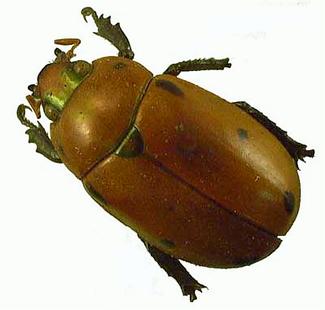
 |


Habitat
Adults: terrestrial
Immatures: terrestrial
Feeding Habits
Adults:
Immatures: phytophagous
Size: 5 to 60 mm
Flight : strong flier
North American
Species: 1400
|
Coleoptera Scarabaeidae
Scarab beetles
Front Wings: hardened
Hind Wings: membranous
Mouthparts: chewing
Antenna Length: shorter than body
Antenna Shape: clubbed
Front Legs: unmodified
Hind Legs: unmodified
Special Characteristics:
The majority of these beetles are dark coloured black or brown but some are brightly coloured. Scarab beetles are heavy-bodied, oval or elongated and the clubbed antennae is composed of 3 to 7 leaves or lamellae.
|
|
Comments: Most adult scarab beetles are either scavengers and feed on dung and other decomposing materials, or phytophagous and feed on grasses, foliage, fruits and flowers. Some of the larvae live on the roots of plants and the emerging adults feed on the foliage of the plants. A few of these beetles are considered serious pests of lawns, golf greens, and various crops. The adults and larvae are nocturnal and are often attracted to light. Some of the largest known beetles belong to this family; for example, the rhinoceros beetles of the tropics is over 120 mm in length.
|
|
Species:
Pelidnota punctata (Linnaeus)
Common Name:
Grapevine beetle
Feeding Habits: The adults feed on the leaves and fruits of wild and cultivated grapes and can become a pest. The larvae feed on decaying wood.
Distribution:
Eastern Canada
Comments:
The larvae are common in wet stumps and rotting fallen trees.
|

|